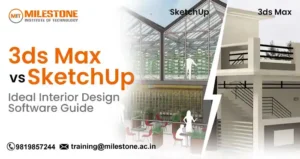In this world of engineering, many of these industries rely mainly on software tools to bring designs to life. Although they are both industry standards, they each have special qualities and advantages that meet various demands. In this complete blog we will understand the detailed information about Revit and AutoCAD software, with a comprehensive comparison between
Revit vs AutoCAD. This article will help you in deciding the best tool for your career journey.
What is Revit?
Autodesk is the most famous company which is known for its best software tools.
Revit is the powerful software which is developed by Autodesk company for BIM (Building Information Modeling). It is designed for creating detailed 3D models of buildings and infrastructure which helps architects, engineers, and construction industry specialists.
Key Features of Revit:
- BIM Capabilities: Revit’s core strength lies in its BIM capabilities, which enable the creation of comprehensive digital representations of physical and functional characteristics of a facility.
- 3D Modeling: Revit allows for sophisticated 3D modeling, which provides a more detailed and accurate visualization of projects.
- Parametric Components: Users can create parametric components that adjust automatically to changes, ensuring consistency throughout the design.
- Collaborative Workflows: Revit supports multi-user environments, making it easier for teams to work on the same project simultaneously.
- Construction Documentation: The software can generate detailed construction documents, ensuring that all design elements are clearly communicated.
What is AutoCAD?
AutoCAD, also developed by Autodesk, is a computer-aided design (CAD) software that has been a staple in the design and drafting industry for decades. Users revere AutoCAD for its versatility and precision in creating 2D and 3D drawings.
Key Features of AutoCAD:
- 2D Drafting and Drawing: AutoCAD excels in creating detailed 2D drawings, making it ideal for drafting floor plans, elevations, and other technical diagrams.
- 3D Modeling: While AutoCAD is traditionally known for 2D work, it also offers robust 3D modeling capabilities.
- Customization: AutoCAD supports extensive customization through scripts, macros, and third-party plugins, allowing users to tailor the software to their specific needs.
- Precision and Control: The software provides precise control over design elements, ensuring accuracy in measurements and details.
- Interoperability: AutoCAD files are widely used and accepted, ensuring compatibility with other software and systems.
Difference Between Revit and AutoCAD – Revit vs AutoCAD
Although they are both strong tools, Revit and AutoCAD have different functions and features.
1. Design Approach:
- Revit: Focuses on BIM, enabling the creation of detailed 3D models that integrate various design and construction disciplines. It promotes a holistic approach to building design and management.
- AutoCAD: Primarily used for 2D drafting and 3D modeling. It is more focused on creating precise drawings rather than comprehensive models.
2. Workflow and Collaboration:
- Revit: Designed for collaborative workflows, allowing multiple users to work on the same project simultaneously. It supports real-time updates and synchronization.
- AutoCAD: Typically used by individual users for creating detailed drawings. Collaboration is possible but not as seamless as in Revit.
3. Application and Use Cases:
- Revit: Best suited for complex projects that require detailed modeling and collaboration across various disciplines, such as architecture, MEP (mechanical, electrical, and plumbing), and structural engineering.
- AutoCAD: Ideal for detailed drafting and design tasks, including floor plans, schematics, and mechanical parts. It is versatile and widely used in various industries beyond AEC.
4. Learning Curve:
- Revit: Has a steeper learning curve due to its comprehensive BIM features and integrated approach to design and documentation.
- AutoCAD: Easier to learn for beginners, especially for those focusing on 2D drafting. Its interface and tools are straightforward and well-documented.
5. File Management:
- Revit: Uses a single project file (.rvt) that contains all the information for a project, facilitating data management and reducing redundancy.
- AutoCAD: Uses separate files for different drawings (.dwg), which can be linked but require careful management to ensure consistency.
Revit vs AutoCAD – Uses Comparison
Revit Uses:
- Architectural Design: Creating detailed architectural models, floor plans, elevations, and sections.
- Structural Engineering: Designing and analyzing structural elements of buildings and infrastructure.
- MEP Engineering: Modeling mechanical, electrical, and plumbing systems within a building.
- Construction Planning: Generating construction documents and coordinating project timelines and costs.
- Facility Management: Managing building information throughout the lifecycle of a structure.
AutoCAD Uses:
- 2D Drafting: Producing precise technical drawings, schematics, and blueprints.
- 3D Modeling: Creating 3D models for visualization and design purposes.
- Mechanical Design: Drafting mechanical parts and assemblies.
- Electrical Schematics: Designing detailed electrical circuit diagrams.
- Civil Engineering: Drafting site plans, layouts, and infrastructure projects.
Which is Better – Revit vs AutoCAD?
Determining which software is better depends on the specific needs and goals of your project.
When to Choose Revit:
- Complex Projects: Revit is ideal for large-scale projects that require detailed modeling and collaboration among various disciplines.
- Integrated Workflows: If your project benefits from integrated workflows and BIM capabilities, Revit is the better choice.
- Lifecycle Management: Revit is suitable for managing building information throughout the entire lifecycle, from design to construction and maintenance.
When to Choose AutoCAD:
- 2D Drafting: For projects that require detailed 2D drawings, AutoCAD is unmatched in precision and control.
- Versatility: AutoCAD is highly versatile and can be used across various industries, making it a good choice for diverse design needs.
- Ease of Use: If you need a tool that is easier to learn and quick to deploy for drafting tasks, AutoCAD is the way to go.
Ultimately, the decision between Revit and AutoCAD should be based on the specific requirements of your project, the complexity of the design, and the level of collaboration needed.
Where to Learn Revit and AutoCAD Software?
For those looking to master
Revit and AutoCAD, the Milestone Institute of Technology offers comprehensive courses that cover both software tools. With experienced instructors and a curriculum designed to provide hands-on experience, students can gain the skills needed to excel in the AEC industry. Whether you are a beginner or looking to advance your existing skills, the Milestone Institute of Technology provides a supportive learning environment to help you achieve your goals.
Frequently Asked Questions
1. Can Revit replace AutoCAD?
Users often use Revit and AutoCAD together, as they have distinct purposes. While Revit is better for BIM and integrated project workflows, AutoCAD excels in detailed 2D drafting. Revit may replace AutoCAD for certain tasks, but many professionals use both tools in tandem.
2. Is Revit harder to learn than AutoCAD?
Revit has a steeper learning curve compared to AutoCAD due to its comprehensive BIM features and integrated approach to design and documentation. However, with proper training and practice, users can become proficient in Revit.
![Revit vs AutoCAD – Which is Better? [Detailed Comparison]](https://milestone.ac.in/blog-mit/wp-content/uploads/2024/05/Revit-vs-AutoCAD-Which-is-Better-Detailed-Comparison.webp)



